
Most birders who have explored outside of the Unted States have labeled the Trogon and its close relative Quetzal as highly desirable sightings. Ask any child or anyone who has eaten Fruit Loops and they know about Toucans! The Toucans are closely related to Barbets and Toucanets. You know we wanted to find them! During our ten days in Ecuador, we would see or hear many different types of these birds. Getting images proved more challenging. I tried on occasion to capture sounds with little luck. It seemed someone was talking, or the sounds were too soft. In this blog, there will be links to some bird sounds. I used a source https://xeno-canto.org. This has many recordings of birds from around the world. I will only share an audio from this source from somewhere really close to where we were.

On our first day of birding, we first traveled to Zuro Loma and then to the Alambi Preserve. Here at an elevation of about 5,000 feet we found many hummingbirds (16), tanagers (5), and the Crimson-Rumped Toucanet. The bill, not quite as large as a Toucan’s, helps them eat fruit, nuts, bird eggs and baby birds. They are drawn to feeders with bananas.
The second day of birding took us to Refugio Paz de las Aves (the place that trained the Giant Antpitta). Here, we would find our first Golden-headed Quetzal. This image is from the second time we found this species on a return visit to the Refugio Paz de las Aves.
Each time Eileen and I were in Costa Rica, the Resplendent Quetzal, famous for its long green undertail feathers (27 inches) that were considered luxury goods by the Mayan and Incan cultures, sat highest on our must-see list. We were successful. So, when we got to Ecuador, we were delighted to see they have a Golden-headed Quetzal. This bird species does not have the long feathers, but it is still a strikingly beautiful, large bird (13 inches with an additional 4 inches of tail). We would find them three different times. Several of those records were audio and not visual. Their repetitive song echoed through the forest making it easy to recognize. Here is a link to a sound file from Xeno-Canto – https://xeno-canto.org/890075.

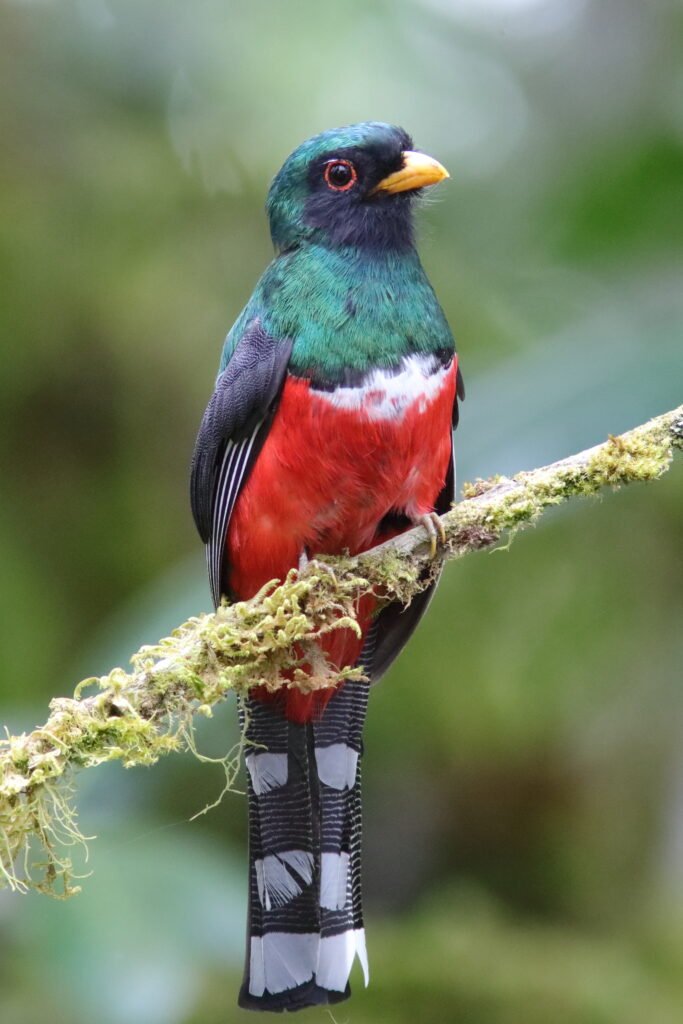
Here we would also find our first Masked Trogon. We would find them on six occasions. They were so tame, I ended up with 9 images. The male has a bright green head with white band separating the head from the bright red chest. The female is brown with the red chest. At this location, we would also see some Toucan Barbets and Crimson-rumped Toucanets though I was unable to get images.
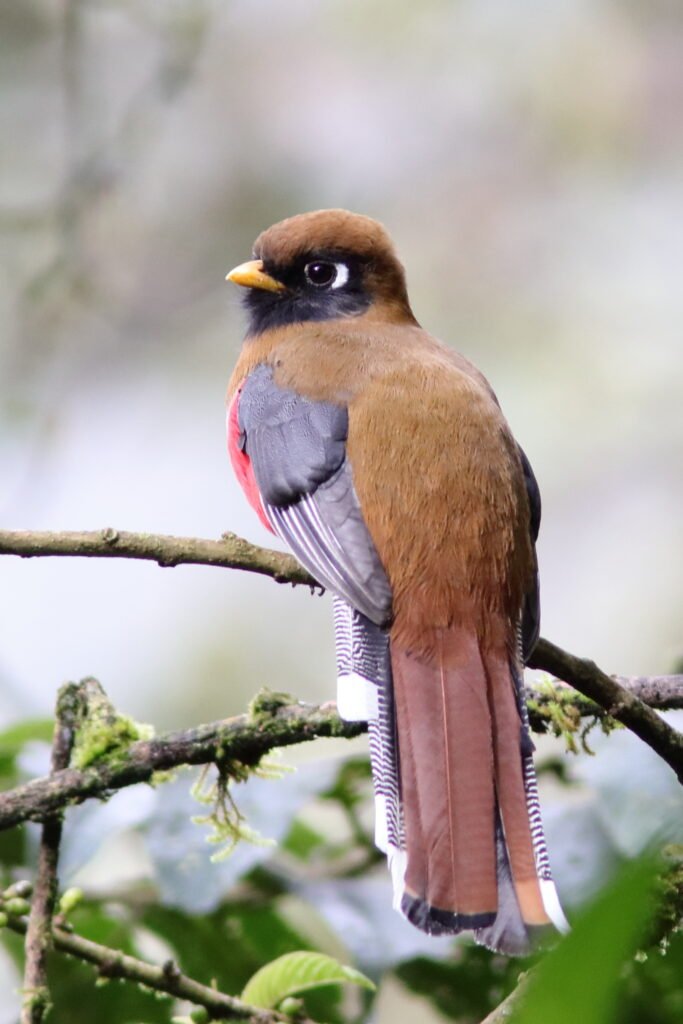
Later in the day, we would travel to Milpe Bird Sanctuary where we would hear but not see Broad-billed Motmot (XC842121 Broad-billed Motmot (Electron platyrhynchum) :: xeno-canto), Yellow-throated Toucan (Chestnut-mandibled), and Choco Toucan (https://xeno-canto.org/845062) .

At 6:22 AM on our third day, we were at the Reserva Mashpi-Amagusa where a female Red-headed Barbet poked her head out of a nest hole and visited the banana feeders. We would visit two other locations on this busy day.
Our fourth day had us at the Rio Silanche Bird Sanctuary at 6:32 AM. The birds we are exploring in this blog put on a show. We had the Blue-tailed Trogon, White-tailed Trogon, Orange-fronted Barbet, Pale-mandibled Aracari, Yellow-throated Toucan and Choco Toucan.
The Blue-tailed Trogon male looks somewhat like the Masked Trogon. It differs by not having that white arc across the breast and the tail is dark as opposed to the checkerboard pattern on the Masked Trogon. This picture shows the male. The female differs from the female Masked Trogon in being gray instead of brown. I was unable to get a photograph of a female. Some sources call it a Choco Trogon as there is an African Blue-tailed Trogon. Like most trogons, the song of the Blue-tailed Trogon (Choco Trogon) sounds like a rhythmic bark or hoot as evidenced in this recording https://xeno-canto.org/112262.


The White-tailed Trogon is the only one with a mostly white tail. Trogons as a family of birds tend to be inactive, frequently sitting still in that vertical position for extended periods of time. For many of us, we find birds by motion. For the Trogons it is more luck or noticing a shape that does not fit the forest. Various species of Trogons can be found in tropical areas throughout the world. Trogons tend to show sexual dimorphism. My images is of a male. Compare this birds song with the Blue-tailed Trogon that we found at the same location. https://xeno-canto.org/122436
Barbets and Toucans are often found in Cecropia trees where they relish the fruit. The Orange-fronted Barbet is another bird that is almost an Ecuadorian endemic. Their population exists only on the western lowlands of Ecuador and just a tiny portion of Columbia. Their song is hardly musical. https://xeno-canto.org/16365
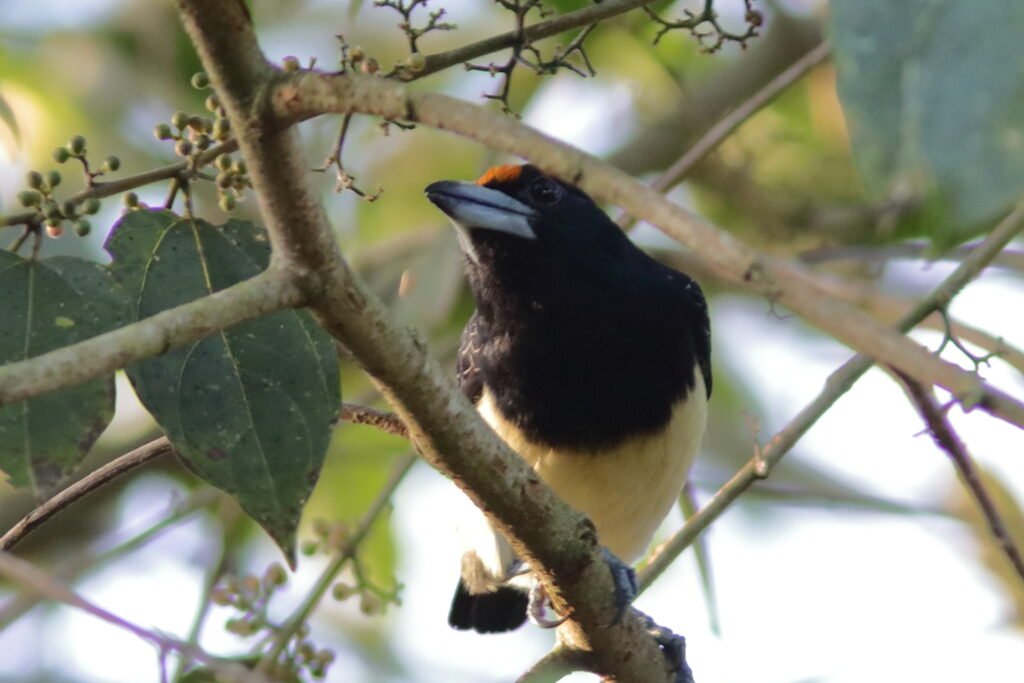

This was the only Pale-mandibled Aracari (pronounced something like “are a sarry”) we saw the whole trip. While the Aracaris superficially look like a Toucan, their bills are much thinner and serrated. The colors are outrageous on these look alike male and female birds. While these birds often move in small groups, we only found this one and it was a treat! This is one of my favorite birds, probably because the first one I ever saw was up close and I had not even studied, so it knocked my socks off. It made no noise as we watched it as they, like many of the other birds in this grouping, are not very vocal.
Compare the Yellow-throated Toucan with the Aracari. That bill is huge (about 7 inches long) and the bird much larger. The smooth edges of the bill is another major difference. There are two subspecies of Yellow-throated Toucan. The one in this picture is the Chestnut Mandibled a resident of the west Andes Mountains. The Black-mandibled subspecies resides in the east Andes. We would see the Yellow-throated Toucan (Black-mandibled) in two days at WildSumaco. Ornithologist wrestle with deciding if this is one species or two. If they decide it is really two, that would mean another lifer for me. This first time we recorded a Yellow-throated Toucan it was by voice only. Their sound is very distinctive and loud. Can you tell the difference between the Yellow-Throated Toucan (Chestnut-Mandibled ) https://xeno-canto.org/928657 and the Yellow-Throated Toucan (Black-mandibled) https://xeno-canto.org/750661? While they look different and live on different sides of the Andes Mountains, they sure sound similar.
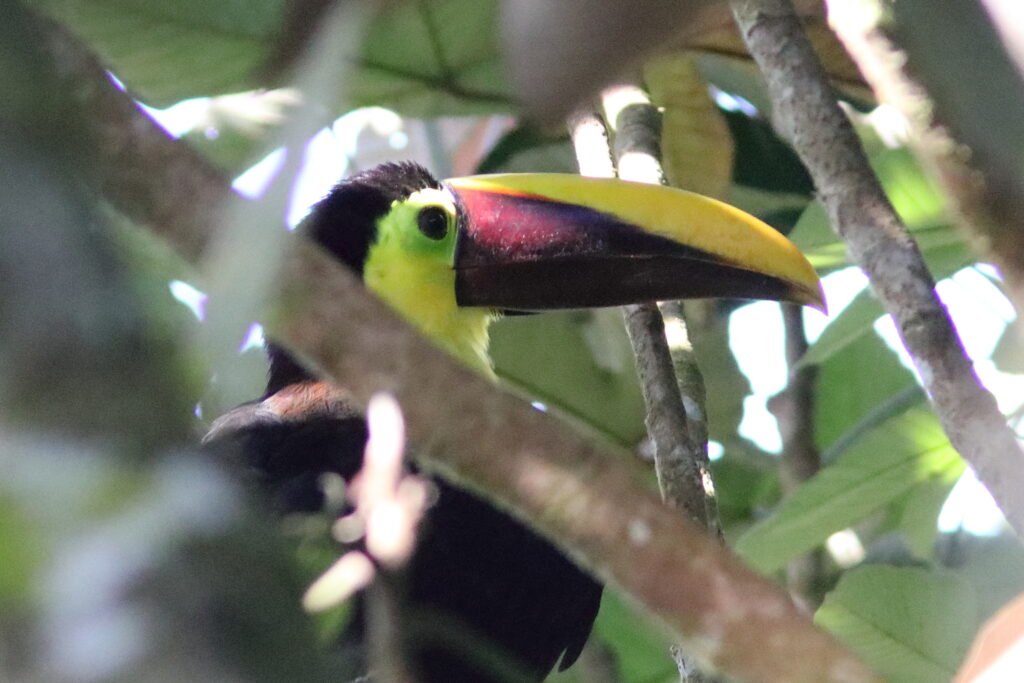
Later that same day, we visited the Sendero Frutti Tour & Birdwatching location. We heard the Choco Toucan which looks very similar to the Yellow-throated Toucan except its lower bill is two toned. We were able to identify this bird by its scratchy frog-like voice https://xeno-canto.org/750672.
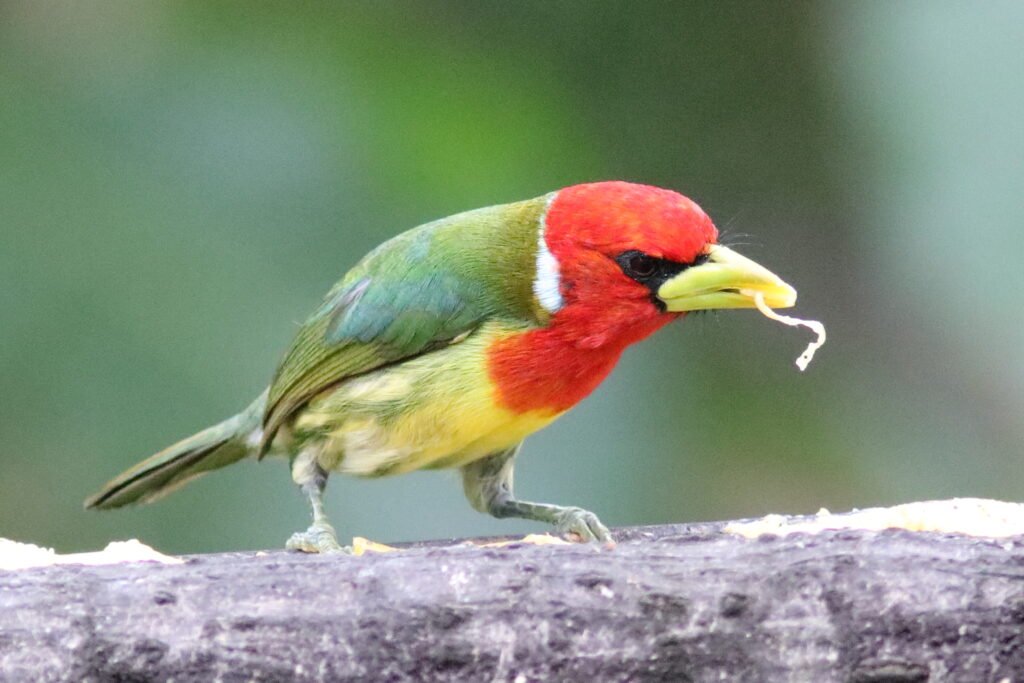
We also found the male Red-headed Barbet feeding at the banana station. He looks quite different from the female with her more muted colors or the Orange-fronted Barbet we saw earlier.
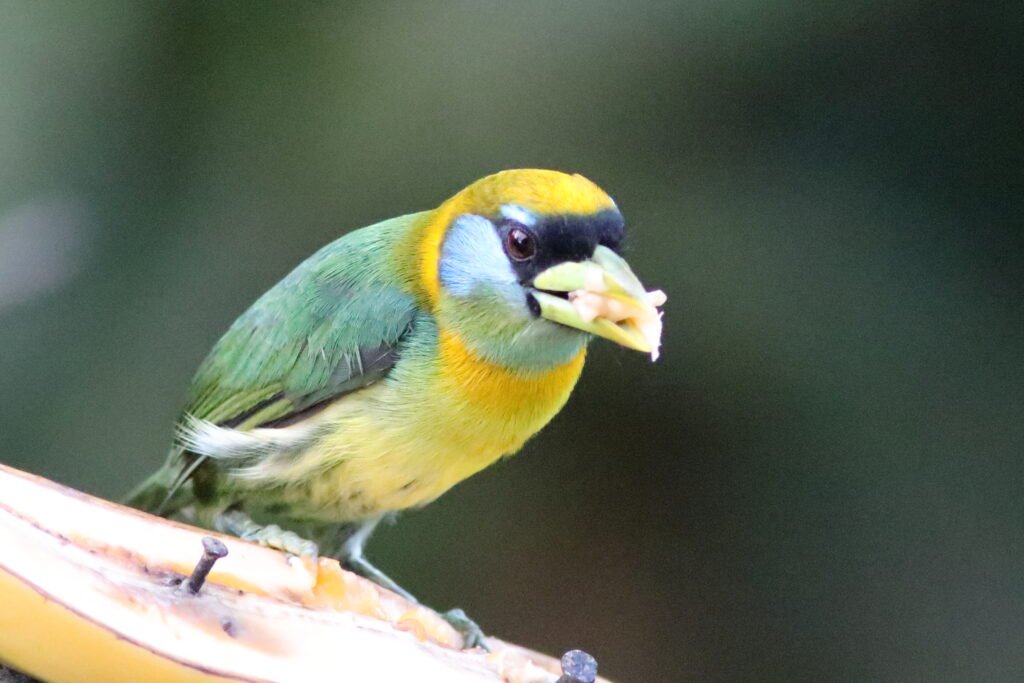

Our fifth day had us arriving at The Birdwatcher’s House at 5:57 AM. We did not have as much luck. We only heard the Crested Quetzal (https://xeno-canto.org/257875) and a Plate-billed Mountain-Toucanet (https://xeno-canto.org/495460) birds that eluded us for the rest of our time in Ecuador. We saw some more Masked Trogons. We could hear a Toucan Barbet calling for the longest time (https://xeno-canto.org/278910), but it was buried in some dense vegetation. Eventually, it came out to give us an identifiable look.
We wouldn’t find any more birds in this group for the next two days. On day six, we drove to the Guango Lodge located on the east side of the Andes Mountain to spend the night. On day seven, we found more Masked Trogons and a Gray-breasted Mountain-Toucan. We watched this bird scarf down a bunch of grapes. I wish I had a video to share as it would roll the grapes around in its bill before swallowing it. Luckily, we were staying at the Guango Lodge, so the 6:10 am start wasn’t too bad. At the Guango Lodge and surrounding area, we would find many new bird species, one’s native to the east side of the mountains.

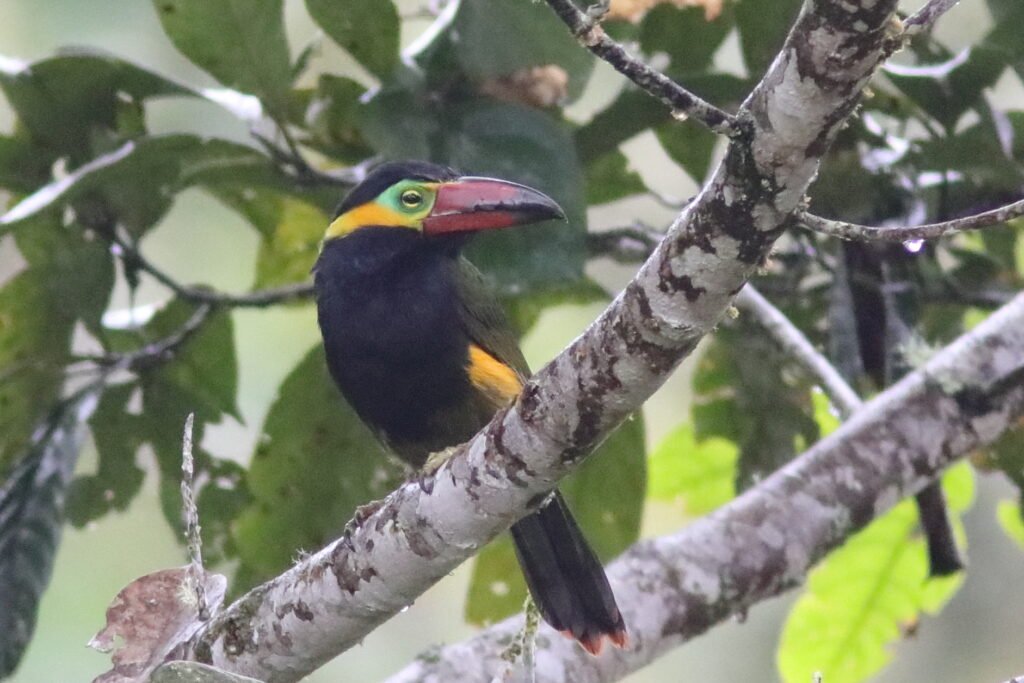
Day nine at the WildSumaco lodge we would find two Yellow-throated Toucan (Black-mandibled) early in the day and later we heard a Golden-collared Toucanet.
We started day 10 at 6:32 am at the WildSumaco Lodge. We spent a very short time there, but the Golden-collared Toucanet and a Channel-billed Toucan made an appearance.
The Golden-collared Toucanet lives in the lowlands of the Amazon. Its deep throaty croaks sound like a huge frog (https://xeno-canto.org/390321). Luckily we were able to see one.
Toucans are loud and noisy birds. Some yelp and others croak. The Channel-billed Toucan croak loudly in a high pitch alerting us to its presence (https://xeno-canto.org/390306). You cannot see it, but the birds common name come from a groove or “Channel” along the length of its bill. These birds are quite common in the Amazonian lowlands. We barely explored any of the Amazonian lowlands.
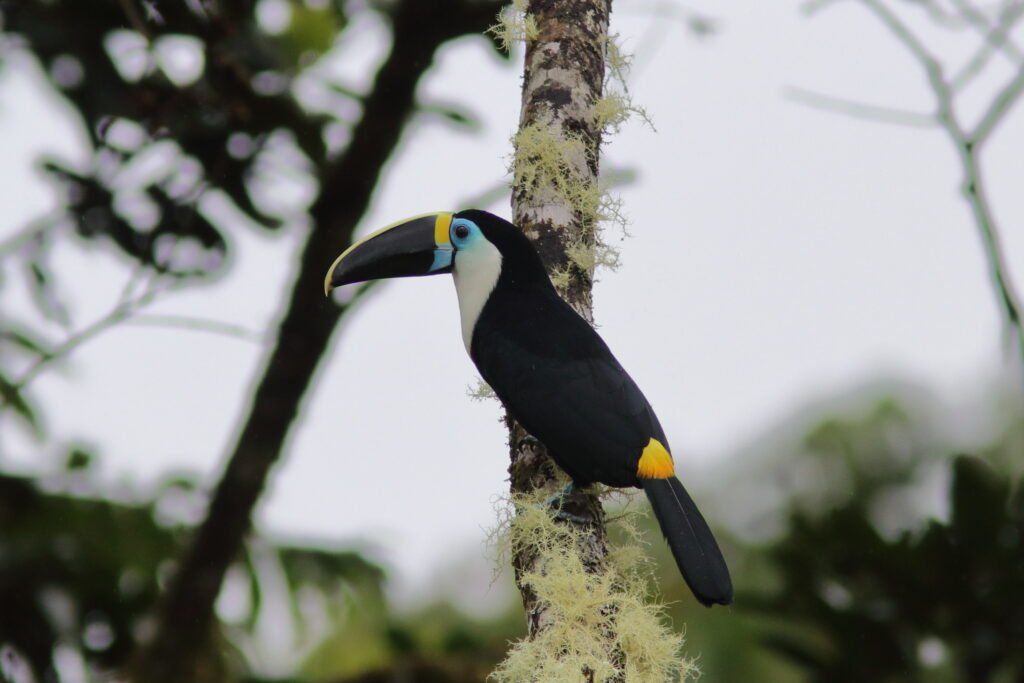
That is the extent of the birds in this interesting group that we would identify while in Ecuador. Every time we found one it was exciting. Unlike so many other species, these are all large and often would sit still for extended periods of time. Who could ask for anything better?
References
All of the audios came from the xeno-canto website. xeno-canto :: Sharing wildlife sounds from around the world It is well worth exploring!
All of the photographs were mine.
